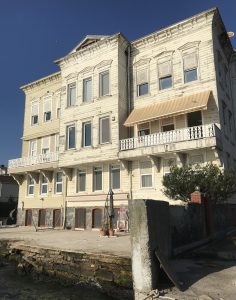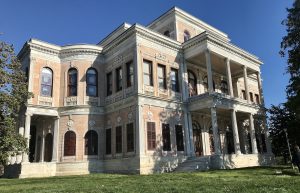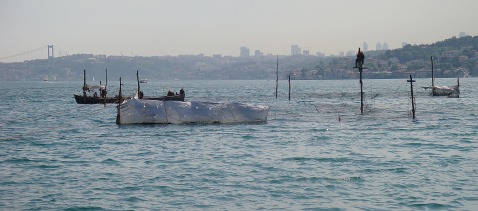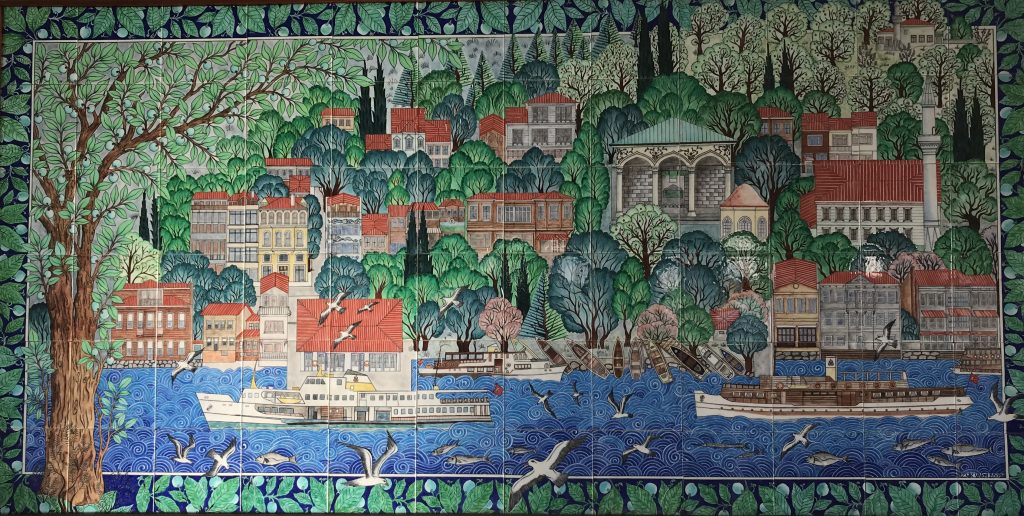Market day: Thursday
Way up the Asian shore of the Bosphorus beyond Paşabahçe lies the airy, open feeling suburb of Beykoz. It was once known for the production of a special kind of blue-and-white stripy glass called çeşm-i bülbül or nightingale glass which was manufactured using a technique imported from Venice in the 18th century. The factory built to mass-produce the glass in 1843 stood beside a fountain of the same name, since lost, as is the factory.
Today you might want to pause in the centre of Beykoz to admire a unique fountain with ten separate water spouts, built originally in the 16th century but completely rebuilt in 1746 by a customs collector named İshak Ağa after whom it was named the İshak Ağa Çeşmesi (although most people know it more simply as the On Çeşmesi, or fountain with ten spouts). Set in a dip with steps leading down it it was completely renewed and repainted in 2008.
Also worth a visit is the lovely Beykoz Wood, what remains of the estate of the fabulously wealthy Abraham (Avram) Paşa (1830-1918), a chamberlain to the Khedive of Egypt and a vizier under Sultan Abdülaziz. Abraham founded the Cercle d’Orient club in what is now the Emek Pasajı on İstiklal Caddesi (now a shopping mall). Unfortunately he was also a gambler who ran up debts that forced him to sell his extravagant house in the woods. It burnt down in 1937 but has been reconstructed and turned into a restaurant. The stable block of Abraham’s house has been turned into the excellent Cam ve Billur Müzesi (Glass and Crystal Museum, closed Mondays, admission TL200, Turks TL60) which displays choice examples of Ottoman glassware alongside stained-glass windows. The beautiful grounds are perfect for picnicking. Walk through the Wood to find it.
A plaque on a waterside yalı in the town centre commemorates the novelist and journalist Ahmed Midhat Efendi (1844-1912) who lived here for the last 22 years of his life. There used to be a small private theatre on the top floor of his home.
Travelling north from Beykoz look out on the inland side of the road and uphill for the grand Hünkar Kasrı/Beykoz Mecidiye Kasrı (closed Mondays, admission TL130, Turks TL40, garden only TL20), a mansion designed by Sarkis and Nikoğos Balyan in 1855 for Kavalılı Mehmed Ali Paşa, a man who actually led an uprising against the Ottomans. This enabled the Russians to get a foothold in Constantinople when the 1833 Treaty of Hünkar İskelesi conceded them the right to bring their warships down the strait and through the Dardanelles. Mehmed Ali intended the mansion as some sort of peace offering. The work was completed by his son, Said Halim Pasa. The mansion and the lovely surrounding gardens with a large cormorant roost are now open to the public with a pleasant small cafe on site.
 To get to the kasrı you will probably cross or walk around Beykoz Meadows where, in the 19th century, Western residents of the city came to play cricket and polo. There are several fine Ottoman fountains in it.
To get to the kasrı you will probably cross or walk around Beykoz Meadows where, in the 19th century, Western residents of the city came to play cricket and polo. There are several fine Ottoman fountains in it.
If you visit in spring or early summer you may still be able to watch dalyan fishing nets set up on poles in the water, a method of fishing that was described by Evliya Çelebi in the 17th century and mainly used to catch lüfer (bluefish). It’s a scene that always looks as if it should be in somewhere far more exotic – Sri Lanka, for example.
Transport info
There are frequent ferries from Yeniköy to Beykoz and less frequent ones from Üsküdar. Otherwise you can get here by dolmuş or by one of the buses in the No 15 series from Üsküdar. Both leave from opposite the harbour.
Nearby areas
Poyrazköy


